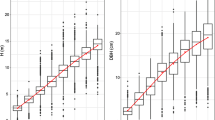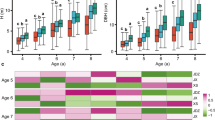Abstract
Parent-pair selection is one of crucial factors that generate progenies with strong heterosis in tree cross-breeding programmes. In our Liriodendron breeding programme, we conducted a very effective strategy on selecting elite parental combinations with strong heterosis on the basis of a large number of crosses and progeny tests. In the past two decades, we have conducted dozens of interspecies crosses in Liriodendron and the hybrids with good performance have been broadly planted for both ornamental and industrial utilization in southern China. In contrast to the application, the genetic mechanism of heterosis in Liriodendron still remains unknown. Genetic distance is one key parameter which has been considered for parent-pair selection. Here, we reported the relationship between parental genetic distance and offspring heterosis by analyzing early growth traits of progenies from intra- and inter-specific crosses in Liriodendron. The genetic distances among 13 parental trees were assessed based on polymorphisms generated from 24 microsatellites loci. Offspring heterosis was estimated based on a 6-year-old progeny test. No significant correlations were found between parental genetic distance and offspring heterosis. However, we found that the offspring heterosis of growth reached the maximum value when parental genetic distance was 1.07, which was validated in another batch of crosses based on 2-year-old growth. Our findings may be helpful for the future parent-pair selection in Liriodendron cross-breeding programmes.


Similar content being viewed by others
References
Ajmone-Marsan P, Castiglioni P, Fusari F, Kuiper M, Motto M (1998) Genetic diversity and its relationship to hybrid performance in maize as revealed by RFLP and AFLP markers. Theor Appl Genet 96:219–227
Balestre M, Machado JC, Lima JL, Souza JC, Filho LN (2008) Genetic distance estimates among single cross hybrids and correlation with specific combining ability and yield in corn double cross hybrids. Genet Mol Res 7(1):65–73
Baranwal VK, Mikkilineni V, Zehr UB, Tyagi AK, Kapoor S (2012) Heterosis: emerging ideas about hybrid vigour. J Exp Bot 63:6309–6314
Baril CP, Verhaegen D, Vigneron P, Bouvet JM, Kremer A (1997) Structure of the specific combining ability between two species of Eucalyptus I, RAPD data. Theor Appl Genet 94:796–803
Benchimol LL, Souza CL, Garcia AAF, Kono PMS, Mangolin CA, Barbosa AM (2000) Genetic diversity in tropical maize inbred lines: heterotic group assignment and hybrid performance determined by RFLP markers. Plant Breed 119:491–497
Bernardo R (1992) Relationship between single-cross performance and molecular markers in maize. Theor Appl Genet 85:1055–1062
Birchler JA, Auger DL, Riddle NC (2003) In search of the molecular basis of heterosis. Plant Cell 15:2236–2239
Boppenmaier J, Melchinger AE, Seitz G, Geiger HH, Herrmann RG (1993) Genetic diversity for RFLPs in European maize inbreeds, performance of crosses within versus between heterotic groups for grain traits. Plant Breed 111:217–226
Chapuis MP, Estoup A (2007) Microsatellite null alleles and estimation of population differentiation. Mol Biol Evol 24:621–631
Chen XD, Sun DF, Rong DF, Sun GL, Peng JH (2010) Relationship of genetic distance and hybrid performance in hybrids derived from a new photoperiod-thermo sensitive male sterile wheat line 337S. Euphytica 175:365–371
Cheres MT, Miller JF, Crane JM, Knapp SJ (2000) Genetic distance as a predictor of heterosis and hybrid performance within and between heterotic groups in sunflower. Theor Appl Genet 100:889–894
Chowdari KV, Venkatachalam SR, Davierwala AP, Gupta VS, Ranjekar PK, Govila OP (1998) Hybrid performance and genetic distance as revealed by the (GATA)4 microsatellite and RAPD markers in pearl millet. Theor Appl Genet 97:163–169
Feng YH, Li HG (2011) Genetic dissection for the reproductive fitness of Liriodendron derived from offsprings of complete-diallel crosses. Sci Silvae Sin 47:43–49 (in Chinese)
Frankham R, Ballou JD, Eldridge MDB, Lacy RC, Ralls K, Dudash MR, Fenster CB (2011) Predicting the probability of outbreeding depression. Conserv Biol 25(3):465–475
Geleta LF, Labuschagne MT, Viljoen CD (2004) Relationship between heterosis and genetic distance based on morphological traits and AFLP markers in pepper. Plant Breed 123:467–473
Hochholdinger F, Hoecker N (2007) Towards the molecular basis of heterosis. Trends Plant Sci 12(9):427–432
Jose MA, Iban E, Silvia A, Pere A (2005) Inheritance mode of fruit traits in melon: heterosis for fruit shape and its correlation with genetic distance. Euphytica 144:31–38
Kwon SJ, Ahn SN, Jeong EG, Hwang HG, Choi HC, Moon H-P (2002) Relationship between genetic divergence and hybrid performance in japonica rice grown in a cold water-irrigated field. Euphytica 128:389–396
Lee M, Godshalk K, Lamkey KR, Woodman WW (1989) Association of restriction fragment length polymorphism among maize inbreeds with agronomic performance of their crosses. Crop Sci 29:1067–1071
Legesse BW, Myburg AA, Pixley KV, Twumasi-Afriyie S, Botha AM (2008) Relationship between hybrid performance and AFLP based genetic distance in highland maize inbred lines. Euphytica 162:313–323
Li HG, Shi JS (2009) Breeding and Propagation of hybrid Liriodendron. Chin For Sci Technol 23(3):1–5 (in Chinese)
Li HG, Chen L, Liang CY (2005) Provenance Test of Liriodendron. Chin For Sci Technol 19(5):13–16 (in Chinese)
Li HG, Cao XM, Yang J (2007) Blooming characteristics and pollinators of Liriodendron chinense and L. tulipifera. J Zhejiang For Coll 24(4):401–405 (in Chinese)
Liu XC, Wu JL (1998) SSR heterogenic patterns of parents for marking and predicting heterosis in rice breeding. Mol Breed 4(3):263–268
Lu H, Romero-Severson J, Bernardo R (2003) Genetic basis of heterosis explored by simple sequence repeat markers in a random-mated maize population. Theor Appl Genet 107:494–502
Martin JM, Talbert LE, Lanning SP, Blake NK (1995) Hybrid performance in wheat as related to parental diversity. Crop Sci 35:104–108
Matsunaga E, Sugita K, Ebinuma H (2002) Asexual production of selectable marker-free transgenic woody plants, vegetatively propagated species. Mol Breed 10:95–106
Melchinger AE, Lee M, Lamkey KR, Hallauer AR, Woodman WL (1990) Genetic diversity for restriction fragment length polymorphisms and heterosis for two diallel sets of maize inbreds. Theor Appl Genet 80:488–496
Muller KE, Fetterman BA (2002) Regression and ANOVA: an integrated approach using SAS software. SAS Institute, Cary
Nei M, Li WH (1979) Mathematical model for studying genetic variation in terms of restriction endonucleases. Proc Natl Acad Sci 76:5269–5273
Oddou-Muratorio S, Vendramin GG, Buiteveld J, Fady B (2009) Population estimators or progeny tests: what is the best method to assess null allele frequencies at SSR loci? Conserv Genet 10:1343–1347
Pamela MK, John LM (2000) Outcrossing rate and inbreeding depression in the perennial yellow bush lupine, Lupinus arboreus (Fabaceae). Am J Bot 87(5):652–660
Paterniani E, Lonnquist JH (1963) Heterosis in interracial crosses of corn (Zea mays L.). Crop Sci 3:504–507
Porebski S, Bailey LG, Baum BR (1997) Modification of a CTAB DNA extraction protocol for plants containing high polysaccharide and polyphenol components. Plant Mol Biol Rep 15:8–15
Reif JC, Melchinger AE, Xia X-C, Warburton ML, Hoisington DA, Vasal SK, Srinivasan G, Bohn M, Frisch M (2003) Genetic distance based on simple sequence repeats and heterosis in tropical maize populations. Crop Sci 43:1275–1282
Riday H, Brummer EC, Cambell TA, Luth D (2003) Comparison of genetic and morphological distance with heterosis between Medicago sativa and subsp. falcata. Euphytica 131:37–45
Ryu KO, Han MS, Noh ER, Kim IS (2014) Age-age correlation on volume growth of yellow poplar (Liriodendron tulipifera L.). J Agric Life Sci 48(3):13–23 (in Korean)
Saghai Maroof MA, Yang G-P, Zhang Q-F, Gravois KA (1997) Correlation between molecular marker distance and hybrid performance in U.S. southern long grain rice. Crop Sci 37(1):145–154
Sant VJ, Patankar AG, Sarode ND, Mhase LB, Sainani MN, Deshmukh RB, Ranjekar PK, Gupta VS (1999) Potential of DNA markers in detecting divergence and in analysing heterosis in Indian elite chickpea cultivars. Theor Appl Genet 98:1217–1225
Smith OS, Smith JSC, Bowen SL, Tenborg TA, Wall SJ (1990) Similarities among a group of elite maize inbreds as measured by pedigree, F1 grain yield, grain yield heterosis and RFLPs. Theor Appl Genet 80:833–840
Stuber CW, Lincoln SE, Wolff DW, Helentjaris T, Lander ES (1992) Identification of genetic factors contributing to heterosis in a hybrid from two elite maize inbred lines using molecular markers. Genetics 132:823–839
Tambasco-Talhari D, Alencar MM, Paz CCP, Cruz GM, Rodrigues AA, Packer IU, Coutinho LL, Regitano LCA (2005) Molecular marker heterozygosities and genetic distances as correlates of production traits in F1 bovine crosses. Genet Mol Biol 28:218–224
Wang Z-R (2005) Interspecies hybridization and utilization in Liriodendron. Chinese Forestry Press, Beijing (in Chinese)
Wang XY, Li HG (2011) Possible mechanism analysis for heterosis of hybrid Liriodendron based on seedling growth and SSR markers. Sci Silvae Sin 47:57–62 (in Chinese)
Wegary D, Vivek B, Labuschagne M (2013) Association of parental genetic distance with heterosis and specific combining ability in quality protein maize. Euphytica 191:205–216
Xiao J, Li J, Yuan L, McCouch SR, Tanksley SD (1996) Genetic diversity and its relationship to hybrid performance and heterosis in rice as revealed by PCR-based markers. Theor Appl Genet 92:637–643
Xu M, Li HG, Sun YG (2010) EST-SSRs development and paternity analysis for Liriodendron spp. New For 40:361–382
Zhang FY, Zhao Y (2005) The research progress in Liriodendron. J Yunnan Agric Univ 20:697–701 (in Chinese)
Zhang QF, Gao YJ, Yang SH, Ragab RA, Saghai Maroof MA, Li ZB (1994) A diallel analysis of heterosis in elite hybrid rice base on RFLP and microsatellite. Theor Appl Genet 89:185–192
Zhang Y, Yang Q, Zhou ZC, Jin GQ (2013) Divergence among Masson pine parents revealed by geographical origins and SSR markers and their relationships with progeny performance. New For 44:341–355
Acknowledgments
This study was financially supported by grants from the National Natural Science Foundation of China (31170621, 31470660), the National Key Technology R&D Program in the 12th Five year Plan of China (2012BAD01B06), Natural Science Foundation of Jiangsu Provincial College (10KJA220017), and the Program Development of Jiangsu Higher Education Institutions (PAPD). We are grateful to Bo Li, Kangqin Li, Xiaofeng Yuan, Xuran Li, Wenting Pan and Binyan Wu for volunteering to assist with plant DNA collection and laboratory work and all kindness. We also thank Bo Zhang for his assistance in language editing.
Data archiving statement
DNA sequences from which primers were developed are accessible in NCBI Sequence Read Database (http://www.ncbi.nlm.nih.gov/Traces/sra/sra.cgi?). Accession number: SRX018894, SRX018897–SRX018900, SRX018906, SRX018908–SRX018911. Detailed primer information can be seen in Xu et al. (2010). doi:10.1007/s11056-010-9205-0.
Author information
Authors and Affiliations
Corresponding author
Electronic supplementary material
Below is the link to the electronic supplementary material.
Rights and permissions
About this article
Cite this article
Yao, J., Li, H., Ye, J. et al. Relationship between parental genetic distance and offspring’s heterosis for early growth traits in Liriodendron: implication for parent pair selection in cross breeding. New Forests 47, 163–177 (2016). https://doi.org/10.1007/s11056-015-9508-2
Received:
Accepted:
Published:
Issue Date:
DOI: https://doi.org/10.1007/s11056-015-9508-2




